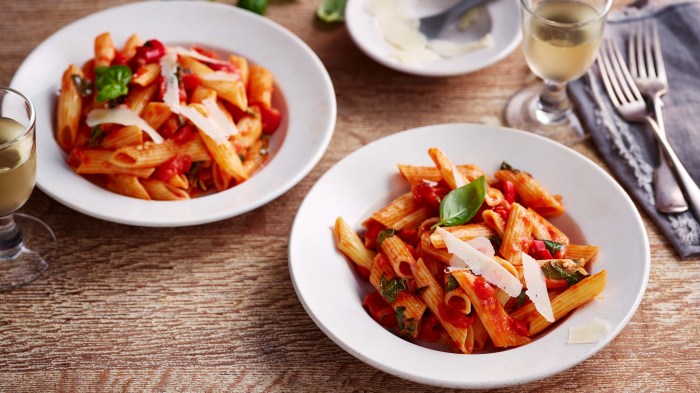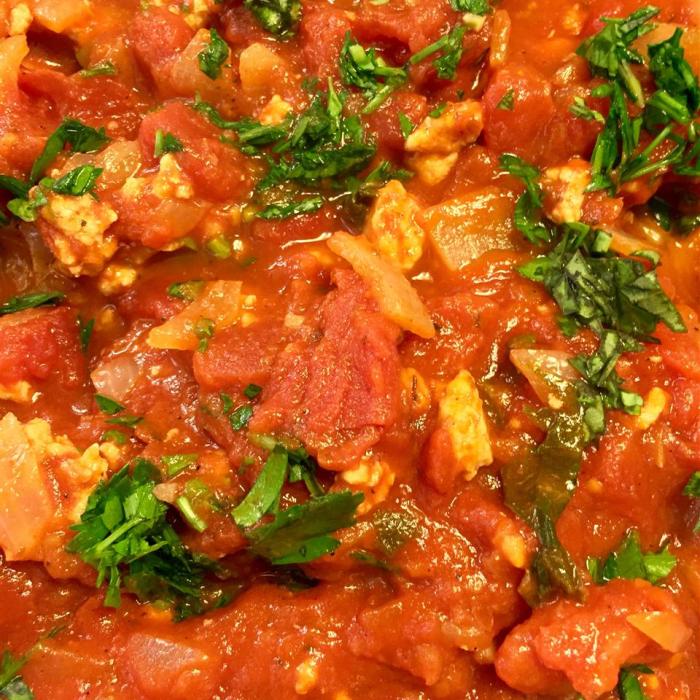Arrabbiata Sauce Recipe A Culinary Guide
Arrabbiata Sauce: A Deep Dive: Arabiatta Sauce Recipe
Arabiatta sauce recipe – Arrabbiata sauce, a fiery delight from the Italian culinary landscape, offers a simple yet intensely flavorful experience. Its origins are steeped in Roman tradition, with variations on its story existing. One popular narrative suggests its creation as a way to utilize readily available ingredients, primarily tomatoes, garlic, and chili peppers, into a flavorful sauce. This straightforward composition belies the depth of flavor achieved through careful ingredient selection and cooking techniques.
Introduction to Arrabbiata Sauce, Arabiatta sauce recipe
Arrabbiata sauce is characterized by its vibrant red color, robust tomato flavor, and a distinct kick of chili heat. While the precise origins remain debated, its popularity stems from its simplicity and versatility. The sauce’s key elements are ripe tomatoes, garlic, chili flakes, and high-quality olive oil. Variations exist, incorporating additional ingredients like herbs (basil, oregano), vegetables (onion, bell pepper), or even meats (guanciale, pancetta).
The level of spiciness can be easily adjusted based on personal preference.
Ingredient Exploration

Source: co.uk
Each ingredient plays a crucial role in defining the Arrabbiata sauce’s unique character. The tomatoes provide the base flavor, while garlic adds savory notes and depth. Chili flakes introduce the characteristic heat, and olive oil provides richness and lubrication. The choice of tomato significantly impacts the final flavor profile; San Marzano tomatoes are often preferred for their sweetness and low acidity.
High-quality extra virgin olive oil is essential for enhancing the overall taste and aroma. Different chili flakes offer varying levels of heat and flavor complexity.
| Chili Flake Type | Heat Level (1-5, 5 being the hottest) | Flavor Profile | Suggested Use in Arrabbiata |
|---|---|---|---|
| Cayenne | 4 | Hot, slightly fruity | For a medium-high heat |
| Aleppo | 2 | Mildly sweet, fruity | For a milder, more nuanced heat |
| Ancho | 3 | Earthy, smoky, slightly sweet | Adds complexity without overwhelming heat |
| Piri-Piri | 5 | Fiery, citrusy | Use sparingly for intense heat |
Recipe Variations and Adaptations
Arrabbiata sauce is highly adaptable, accommodating diverse dietary preferences and spice levels. The following recipes illustrate its versatility:
- Classic Arrabbiata: This version utilizes simple ingredients, focusing on the balance of tomato, garlic, and chili flakes.
- Vegetarian Arrabbiata: Enhances the classic recipe with the addition of vegetables like bell peppers or mushrooms, providing additional texture and flavor.
- Spicy Arrabbiata: This recipe increases the amount of chili flakes and incorporates a touch of hot sauce for an extra fiery kick.
Adjusting the spiciness is easily achieved by controlling the amount of chili flakes used. Start with a small quantity and gradually increase to your desired heat level.
Suggested additions include fresh or dried herbs (basil, oregano, parsley), vegetables (zucchini, eggplant), or meats (Italian sausage, pancetta).
Cooking Techniques and Methods
Making Arrabbiata sauce involves a straightforward process. Garlic is sautéed in olive oil until fragrant, then the crushed tomatoes and chili flakes are added. The sauce simmers gently, allowing the flavors to meld. Blending is optional, depending on the desired consistency. Proper cooking time is essential to develop the rich, complex flavors.
Simmering for at least 30 minutes allows the sauce to reduce and intensify.
While stovetop preparation is common, slow cookers can also be used for a hands-off approach. The slow cooking method yields a richer, more concentrated sauce.
Serving Suggestions and Pairings

Source: media-allrecipes.com
Arrabbiata sauce pairs beautifully with various pasta shapes. Its robust flavor complements short pasta like penne, rigatoni, and fusilli, which effectively capture the sauce.
| Pasta Dish | Pasta Shape | Additional Ingredients |
|---|---|---|
| Classic Arrabbiata Pasta | Penne | Parmesan cheese, fresh basil |
| Arrabbiata with Sausage | Rigatoni | Italian sausage, red pepper flakes |
| Vegetarian Arrabbiata with Mushrooms | Fusilli | Cremini mushrooms, spinach |
Complete meals can be created by adding grilled chicken or fish, a simple salad, and crusty bread.
Visual Representation of the Recipe
Initially, the sauce is a vibrant mix of red tomatoes and specks of chili flakes. As it simmers, the color deepens, becoming a richer, more intense red. The consistency transitions from chunky to smoother, depending on whether blending is employed. The texture changes from initially coarse to a velvety smooth consistency after simmering. The aroma intensifies as the sauce cooks, filling the kitchen with the scents of tomato, garlic, and chili.
Troubleshooting Common Issues
Common problems include burning, the sauce being too watery or too spicy. Burning can be prevented by using medium-low heat and stirring frequently. A watery sauce can be remedied by simmering longer to reduce excess liquid. If the sauce is too spicy, adding a dollop of cream or a spoonful of tomato paste can help to balance the heat.
Storage and Shelf Life
Leftover Arrabbiata sauce should be stored in an airtight container in the refrigerator. It will maintain its quality for up to 3-4 days. Freezing is also an option; the sauce can be stored in the freezer for up to 2-3 months. Ensure the sauce is completely cooled before freezing to prevent ice crystal formation.
FAQ Summary
Can I make Arrabbiata sauce ahead of time?
Yes, Arrabbiata sauce can be made ahead of time and stored in the refrigerator for up to 3 days or frozen for longer storage.
What if my Arrabbiata sauce is too watery?
Simmer the sauce uncovered for a longer period to reduce the liquid. You can also add a tablespoon of tomato paste to thicken it.
Arabiatta sauce, with its simple elegance of tomatoes and chili flakes, is a classic. For a completely different flavor profile, consider the surprising sweetness and heat you can achieve with an apple hot sauce recipe ; it’s a fantastic alternative if you’re looking to experiment. Returning to arabiatta, remember the key is to let the sauce simmer gently to develop its rich, deep flavor.
What can I substitute for chili flakes?
You can substitute with a finely chopped fresh chili pepper, adjusting the amount to control the heat level. Cayenne pepper can also be used.
What type of pasta pairs best with Arrabbiata?
Short, thick pasta shapes like penne, rigatoni, or fusilli work well due to their ability to capture the sauce.





















